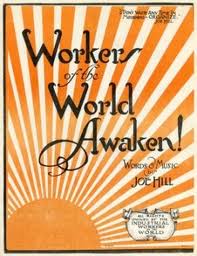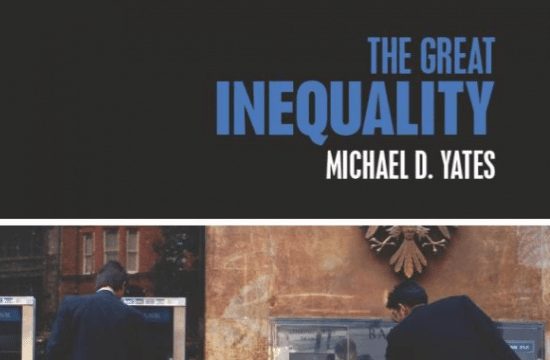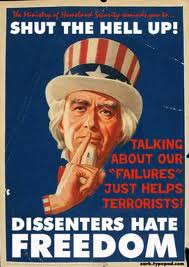 In the United States, radical labor education had great vitality from the heyday of the Socialist Party and the IWW before the First World War until the end of the Second World War. In fact, much of the impetus for labor education came from the left, and a good deal of what was taught had an explicit or implicit anti-capitalist bias. This reflected the fact that there were strong progressive currents within the labor movement throughout this time. Even the conservative American Federation of Labor, which was usually strongly opposed to any critical labor education, sometimes supported schools with a radical focus. Socialists and communists found havens in the left-wing political parties and the industrial union movement, and their students did the same.
In the United States, radical labor education had great vitality from the heyday of the Socialist Party and the IWW before the First World War until the end of the Second World War. In fact, much of the impetus for labor education came from the left, and a good deal of what was taught had an explicit or implicit anti-capitalist bias. This reflected the fact that there were strong progressive currents within the labor movement throughout this time. Even the conservative American Federation of Labor, which was usually strongly opposed to any critical labor education, sometimes supported schools with a radical focus. Socialists and communists found havens in the left-wing political parties and the industrial union movement, and their students did the same.
Of course, there were many problems that confronted radical labor education in addition to AFL antagonism. The independent colleges were perennially short of funds and were often at odds with the labor unions. The same was true for the party-based schools. Some of the energy and independence of the labor movement was coopted by the New Deal. And even in the left-wing unions, there was conflict between their immediate needs and the more long-term goals of the educators. But, all in all, radical labor education had achieved much and was poised to achieve more at the end of the Second World War. Union membership was at an all-time high, and the rank-and-file were ready for action.
Unfortunately, the postwar period brought the ferocious Cold War assault on the labor left, the result of which was that the radicals, including the educators, were defeated by the corporations and the state, with help from the AFL and liberal opportunists in the CIO like Walter Reuther. This assault has been well-documented and needs little further comment, except to say that the withdrawal or expulsion of the CIO’s left-led unions foreshadowed the collapse of an independent labor movement. Not long after the merger of the AFL and the CIO in 1955, union density began its long decline. Even the economic gains that labor won as a part of the “deal” it made with capital—in which organized workers got regular wage increases and a package of fringe benefits in return for unilateral management control of the capital and union discipline of rank-and-file dissidents—could not withstand the end of the long period of postwar prosperity that began in the mid-1970s. By the time Reagan became president and broke the Air Traffic Controllers Union, the labor movement was, for all practical purposes, already dead.
The fortunes of the broader left spiraled downward as the labor movement moved to the right. There were important periods of revival, notably the civil rights, antiwar, and student uprisings of the 1960s. But, without labor to nurture and support them, these movements fell upon hard times as well. The 1980s were an especially bleak decade for radicals. The political spectrum moved so far to the right that moderate opinions now sounded extreme. Millions of working people voted for Reagan and Bush, architects of the very policies that devastated their living standards. Left-wing parties around the world were driven from power or put sharply on the defensive. Marxism, both as theory and as praxis, was in disarray, savaged by opponents and abandoned by many former adherents. At the end of the decade the abrupt collapse of the Soviet Union and its satellites left capitalism triumphant. Ever since, ideologues have trumpeted its victory in the Cold War as proof that it is the only imaginable economic system, the only one in accord with human nature. Anyone arguing otherwise was dismissed as a hopeless romantic; capitalism’s power was so awesome that it could never be defeated, so we had better be prepared to accept it as inevitable. The capitalist economy, usually described with euphemisms such as “market forces” or the “magic of the marketplace,” had taken on an almost god-like quality, immutable and impervious to human action. Even stalwart critics like the late Robert Heilbroner threw in the towel and said that the socialist project was a pipe dream.
These events made it difficult for radical labor educators to get work let alone to teach what they believed to be true. The independent and the party-based schools either did not survive or changed their focus away from labor. Education sponsored directly by the unions focused almost exclusively on collective bargaining and contract administration. This was the natural result of labor’s acceptance of the postwar “accord” with capital, with its emphasis upon labor-management cooperation and peaceful collective bargaining. Much the same could be said about college-based labor education; while it maintained some independence, it was still tied closely to the wishes of the unions it served. In addition, the dominant academic paradigm was the “industrial relations” model, which raised the “accord” to the level of natural consequence of the development of advanced capitalist economies.
I can attest to the difficulties that faced radical labor educators during this long dark age. Through the Labor Studies Department at Penn State University, I began teaching workers in 1980. My circumstances were not as bleak as those who taught in the 1950s, since at least by 1980, many colleges and universities had been opened to left-wingers. In fact, many of my contemporary college-based labor educators were products of the revolts of the 1960s. Nonetheless, it was difficult for me to raise certain issues in my classes. For example, in labor economics, I utilized Marx’s labor theory of value, but I was leery of using Marx’s name. Instead, I used the subterfuge of calling Marx’s analysis the “workers’ theory.” I had to be careful about discussing U.S. imperialism; I was once sharply criticized for showing a film featuring former CIA agent and ardent radical, Philip Agee. I avoided altogether discussion of noncapitalist ways of organizing production and distribution, fearing that this would mark me as a communist and damage my credibility with the students. Some of them even got upset when I extolled the virtues of the most liberal capitalist regimes, such as those in Scandinavia. As late as the mid-1990s, red flags were waved at the AFL-CIO when I was asked to teach a two-week class to union staff in a Labor Studies program at the University of Massachusetts.
One thing I did do during the 1980s was to become more critical of the failures of the labor movement, specifically its willingness to support the ideology of the employers it was supposed to be fighting and its unwillingness to aggressively organize new members, especially the millions of women and minorities who would soon be a majority of new entrants into the labor force. I thought, too, that the conditions of the working class had entered a period of long-term decline, with stagnating wages and widening inequality and without the likelihood that the government would do anything to ameliorate working class misery. I devoted my classes to explaining the political economy and pointing out the delusional thinking that saw labor-management cooperation as good strategy for unions and their members. I urged students not to look for scapegoats and easy solutions.
I thought of my labor education work as a small bulwark against reaction. Perhaps I could create a few tiny islands of progressive thinking in a sea of backwardness, and these islands could provide bases for a renewal of working class consciousness when conditions changed. I had some success. Students took what they learned in a collective bargaining class and used it to defeat the employer-friendly incumbents running their local. Then they forced their district union officers to abandon the mid-contract concessions they were going to grant to my students’ employer. I thought that maybe things were changing. As I would soon find out, they were.
To be continued . . .







Thanks, Mike for your review of the radical workers’ education work down through the years. No doubt it has been a difficult several decades. There is always good work to be done on this front, however, and I offer myself as an example of an ordinary worker who never would have taken the plunge into labor and the left were it not for this kind of informal training. Coming from a long line of poor and working class Republicans from Pennsylvania how on earth would it have been possible for me to learn the leftwing facts of life without the informal schools and study groups of the lefties?
We were taught by the old-timers that, “no organizing effort is ever wasted” and I’ll say the same about workers’ education; “no radical workers’ education is ever wasted.”
I’ll stay tuned for the remainder of this subject. Belated Happy New Year to you and Karen wherever this finds you. Chris Towsnend, UE
Thanks, Chris. It is good to hear from a person who found radical labor education useful. Makes me feel good.
Happy New Year to you, brother. We’ll be somewhere in the west in a couple of weeks. My labor ed class in Amherst went well. In my hometown in PA right now.
I just got this very interesting book Generation of Resistance: The Electrical Unions and the Cold War by John Bennett Sears. It discusses the United Electrical Workers which continued to propagade an anti-imperialist position well into the cold War.
I stumbled across this website a few weeks ago and am enjoying this series on radical labor education. I only wish I could have received a bit of this education 25 years ago when I was a student. That said, I’m trying to make up for lost time now, educating myself. I read Sharon Smith’s Subterranean Fire recently and was appalled at the amount of history I should have learned in school that was never even presented. Any recommended reading material you might suggest would be appreciated.
Thanks again for taking the time to write and post, it’s never wasted.
Good piece as usual. I think you are right to pinpoint the ideological offensive after the collapse of the Soviet Union and the defeat of PATCO as critical moments in the demise of both the left and the labor movement. While it isn’t always tasteful to name names, the sectarian degeneration of the SWP also helped to demoralize a generation of potential labor activists.
Also, like your work and other labor educators, I think that the Labor Party of the 90s was a bulwark against reaction in swimming against the stream. I was very glad to see that MR is publishing a book about Gould. I’ve only read Mismeasure of Man, and it was very educational.